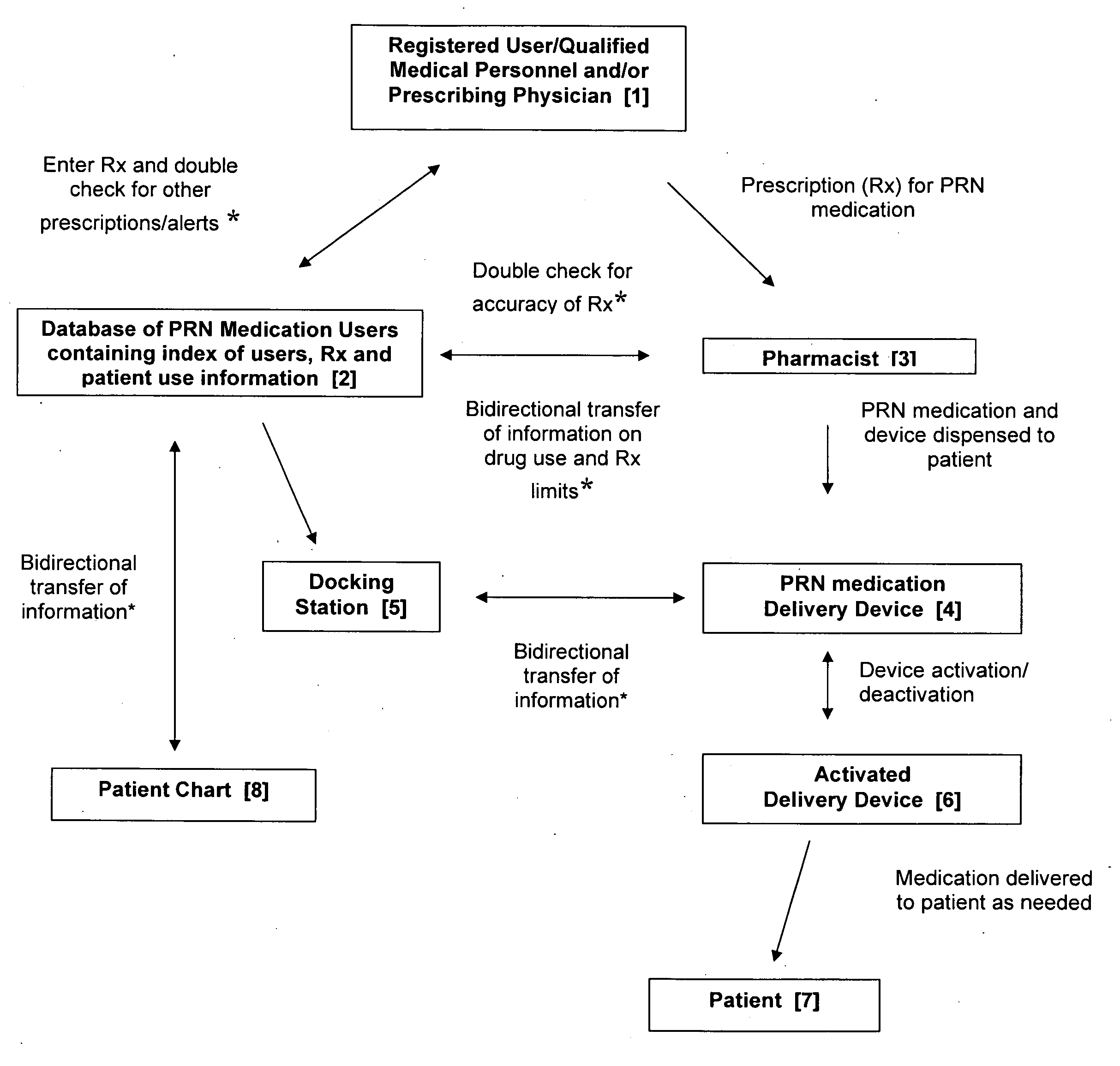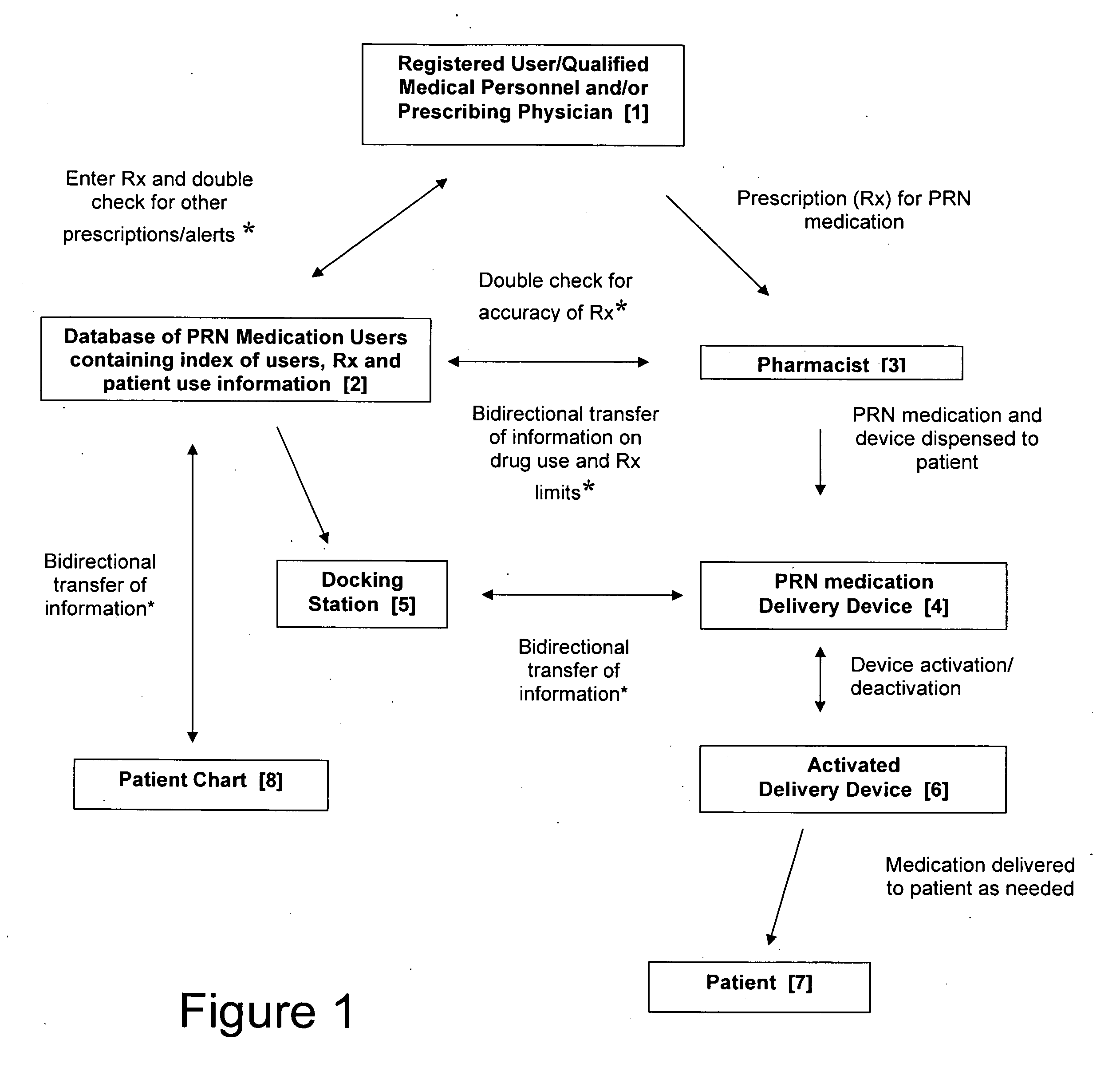Inpatient system for patient-controlled delivery of oral transmucosal medications dosed as needed
a technology for transmucosal medications and inpatient settings, which is applied in the field of system for administering and monitoring of oral transmucosal medications, can solve the problems of delayed effectiveness of oral medications, inability to monitor and inability to accurately diagnose the effect of oral medications
- Summary
- Abstract
- Description
- Claims
- Application Information
AI Technical Summary
Benefits of technology
Problems solved by technology
Method used
Image
Examples
example 1
Exemplary Inpatient System For Delivery And Monitoring Of Administration Of Sufentanil
[0127]A 56 year-old gentleman is taken to the recovery room after having a partial colectomy. He receives intravenous (IV) fentanyl from the nurse in the recovery room until he is comfortable and then he is transferred to his post-surgical hospital room. He is then given a hand-held device by his nurse, which is RFID tagged to the patient and dispenses, when placed under the tongue, a very small sublingual tablet containing 5 microgram dose of sufentanil in a controlled manner, including a 10 minute lock-out time. This device has been ordered by the surgeon for his post-operative pain control. The device is in electronic communication with the electronic nursing chart for this patient. As the patient dispenses the tablets sublingually on an “as-needed” basis for pain control, total amount dispensed every shift is automatically recorded in his chart. The dispenser also contains a mechanism for the p...
example 2
Exemplary Inpatient System For Delivery And Monitoring Of Administration Of Terbutaline
[0128]A 36 year-old pregnant woman is admitted to the obstetrical floor in a hospital for pre-term labor. She is having contractions 10 times per hour. She is placed on bed-rest and given a hand-held device which dispenses very small sublingual tablets containing 500 microgram doses of terbutaline in a controlled manner, including a 30 minute lock-out time. The device has been ordered by her obstetrician to treat her pre-term labor and it is RFID tagged to the patient. The device has a pulse rate detection unit, which will not allow a tablet to be dispensed unless the heart rate is lower then the cut-off rate set by the physician, such as 115 bpm. Terbutaline can increase heart rates to dangerously high levels and therefore heart rate must be monitored. The patient notes after dosing herself with the first sublingual tablet that during the next 30 minutes, instead of having 5 contractions, she had...
example 3
Exemplary Inpatient System For Delivery And Monitoring Of Administration Of Alprazolam.
[0129]A 55 year-old male patient has just been diagnosed with colon cancer and is hospitalized for partial bowel obstruction and is awaiting exploratory surgery. He is having numerous episodes of anxiety attacks, which produce rapid pulse rate, high blood pressure and irritability towards the nurses. His surgeon orders for him a hand-held device, which dispenses very small sublingual tablets of 0.125 mcg of alprazolam in a controlled manner, including a 30 minute lock-out time. The device is RFID tagged to this patient. The patient feels less anxious knowing that he has control over his anxiety medication and that it can be dosed as needed instead of around-the-clock. He also likes the more immediate-release aspect of the sublingual delivery instead of swallowing a pill. The dosing of the alprazolam tablets is electronically transmitted to the nursing chart along with the patient's anxiety score, ...
PUM
 Login to View More
Login to View More Abstract
Description
Claims
Application Information
 Login to View More
Login to View More - R&D
- Intellectual Property
- Life Sciences
- Materials
- Tech Scout
- Unparalleled Data Quality
- Higher Quality Content
- 60% Fewer Hallucinations
Browse by: Latest US Patents, China's latest patents, Technical Efficacy Thesaurus, Application Domain, Technology Topic, Popular Technical Reports.
© 2025 PatSnap. All rights reserved.Legal|Privacy policy|Modern Slavery Act Transparency Statement|Sitemap|About US| Contact US: help@patsnap.com


